Recent Water Damage Posts
Flooding Happens in the Blink of an Eye
5/24/2024 (Permalink)
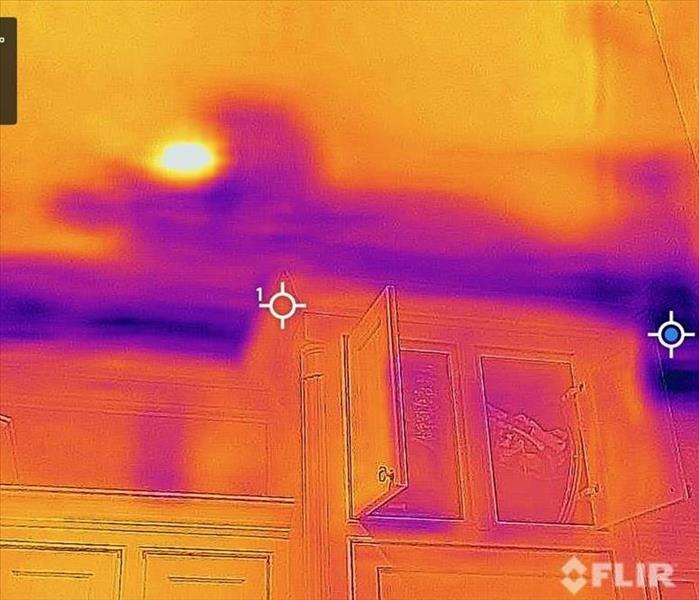 Thermal image of wet ceiling and cabinets following an upstairs toilet leak. Purple indicates moisture evaporating from drywall.
Thermal image of wet ceiling and cabinets following an upstairs toilet leak. Purple indicates moisture evaporating from drywall.
Residential leaks and floods can be catastrophic, but quick intervention is key to reducing potential damage:
Depending on the source of the leak, water can fill your space quickly or slowly creep along undetected, saturating everything it encounters.
Water always flows along the “path of least resistance”, which means it can seep into walls, floors, furnishings, and personal items.
Within the First Day of being wet:
- Drywall starts to swell and deteriorate.
- Metal surfaces start to tarnish.
- Furniture begins to swell and develop cracks.
- Dyes and inks from textiles and paper products spread, causing staining.
- An unmistakable musty odor starts to emanate.
48 Hours to One Week:
- Mold and mildew may start to flourish and spread.
- Doors, windows, and structural components may begin to swell and warp.
- Metal surfaces may start to rust and corrode.
- Furniture warps and shows signs of mold growth.
- Paint may begin to bubble and peel.
- Wood flooring may swell and buckle.
- There's a risk of serious biohazard contamination.
Beyond One Week:
- The time and expense of restoration increase significantly; replacing contaminated materials and extensive structural repairs may be necessary.
- Occupant safety is jeopardized due to structural instability, possible proliferation of mold, and other potential biohazards.
Does the Source of Flood Water Matter?
5/7/2024 (Permalink)
 Wall damaged by broken toilet supply line. The source was clean water, so it was determined to be Category I.
Wall damaged by broken toilet supply line. The source was clean water, so it was determined to be Category I.
Flooding wreaks havoc on homes and commercial properties, leaving behind a trail of destruction that's often difficult to fully anticipate.
The initial step in mitigating water and storm-related damages is water extraction, but that's only the beginning of the comprehensive restoration process undertaken by the restoration professionals from SERVPRO of Northeast Dallas. Given the inherent dangers of flooding, it's crucial to enlist the expertise of a reputable property damage restoration company like ours, specializing in natural disaster and flood cleanup and remediation.
For property owners or management teams, determining whether contaminated areas and contents have been effectively remediated can be challenging, necessitating professional intervention to prevent ongoing damage from potential mold growth. Our restoration technicians, equipped with IICRC training and certification and extensive experience in local property damage cleanups and repairs, assess the damage meticulously.
During the assessment process, SERVPRO of Northeast Dallas identifies which aspects of the loss can be cleaned, sanitized, and restored, collaborating seamlessly with our construction crews and management to facilitate a smooth transition from mitigation to reconstruction. Thus, entrusting the restoration process to a local property disaster restoration company like ours ensures comprehensive and efficient damage reversal.
When it comes to contaminated water, understanding the different categories is crucial:
Category 1: Originating from an uncontaminated source of clean water, such as a broken water supply line or a leaking hot water heater, Category 1 water poses minimal risk initially but may become contaminated upon contact with other surfaces or materials. We always attempt to dry surfaces as quickly as possible to prevent additional damage and avoid the need for demolition.
Category 2: Often called "gray water", it carries slight contamination that can cause discomfort or illness if consumed or contacted by humans. One example would be water that leaks from a dishwasher drain line. This type of water may contain unsafe levels of microorganisms, nutrients, or other organic or inorganic matter. Depending on the situation, some surfaces can be disinfected, cleaned, and dried, while others will need to be removed.
Category 3: Known as "black water", it is highly contaminated and harbors pathogenic, toxigenic, or otherwise harmful agents. This category includes sewage backups, ground water, or surfaces that have remained wet for over five days. Dealing with black water requires professional expertise due to its hazardous nature. Most surfaces that come into contact with Category 3/Black Water must be removed.
Different categories of contaminated water present varying risks, but prolonged exposure exacerbates property damage and health hazards.
If you are dealing with any type of flood, contact SERVPRO of Northeast Dallas as soon as possible.
What Leads to Flooding in Basements?
11/8/2022 (Permalink)
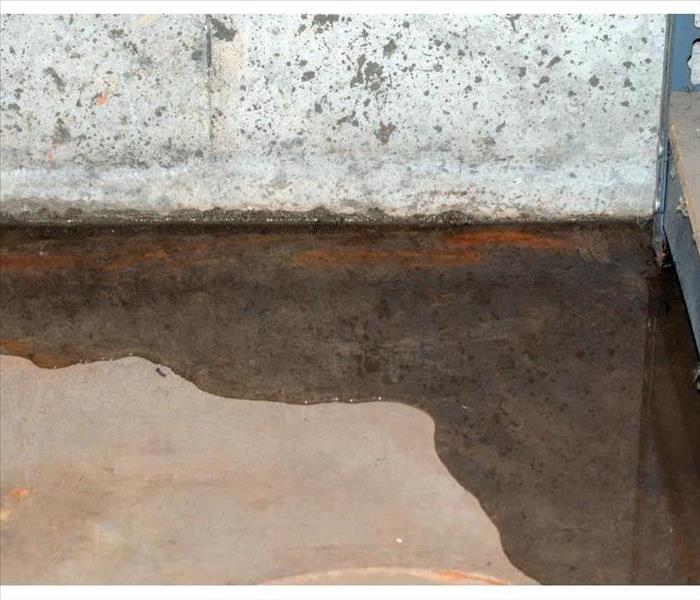 Foundation cracks can allow water to seep into your basement.
Foundation cracks can allow water to seep into your basement.
What Causes Basement Flooding?
There are many reasons why your basement may be flooded. The good news is that most of these issues can be prevented by checking and maintaining the areas around your home. The following are some of the most common causes for flooding in basements.
1. Plumbing leaks
A plumbing leak could result from any of the following:
- A cracked pipe
- Leaking faucet or fixture
- Broken valve
2. Foundation cracks
Foundation cracks can allow water to seep into your basement. To check for foundation cracks, look at the floor joists that support your home's walls. If you see any cracked or bowed areas, these may be signs of a problem.
To fix this issue, call in a professional who will use either wood or dry-set concrete blocks to restore the support system underneath your home. This will prevent further damage from occurring and keep any water from seeping into your basement in the future.
3. Sewage backups
Sewage backups are a common problem in basements. When your home's pipes and drains become clogged, sewage can back up into the basement, causing serious damage to your property. Sewage backups occur when water remains stagnant in a drain or sewer line for too long. This happens most often when leaves and other debris block the pipe, preventing waste from being properly disposed of. If you notice any of these signs—a strange smell coming from your drainage system, standing water in the bottom of your sink or toilet bowl—it may be time to check for leaks or clogs before it becomes an emergency:
Once it's safe to enter the area where backup occurred (always wear protective gear such as rubber gloves when handling wastewater), place clean towels around affected areas to absorb excess moisture before attempting any cleanup efforts by hand with paper towels or rags that can later be thrown away immediately outside (never through drains). Be sure not touch anything unless wearing protective clothing as well as washing hands thoroughly after contact with any potentially harmful substances like mold spores.
4. Clogged gutters
Gutter systems are an important part of the foundation, and they can be a great first line of defense against water damage. However, if you don't keep your gutters clean, clogging will occur. This is more likely to happen if there are leaves or other debris in the gutter system that prevent water from flowing freely through it. When this happens, water may back up and seep into your basement.
5. Flooded yard
Sump pumps are an important part of flood prevention. They help get rid of excess water in the yard, preventing it from entering your basement through cracks in the foundation. Sump pumps can be installed in a pit or sump basin, which is essentially just a hole dug into the ground with a pump on top of it. The pump should have its own dedicated power source and be connected to PVC piping that leads to an overflow drain outside of your house.
There are some things you can do to prevent basement flooding. Make sure that you check your plumbing regularly for leaks and try not to overload your drains with too much water. If there is ever a sewage backup, call a professional immediately before the problem gets worse. You should also have your yard inspected regularly by a professional landscaper who will help identify any potential problems before they become serious enough that they cause flooding in your Northeast Dallas, TX home.
How To Know Whether You Have a Shower Leak
8/27/2022 (Permalink)
 Shower leak
Shower leak
How to Determine If Your Shower Is Leaking
A bathtub leak can quickly damage the floors and walls of your Vickery Meadows, TX, home. You thus need to regularly inspect your shower and bathtub for signs of damage. Otherwise, your house may sustain extensive flooding that necessitates water damage remediation experts.
Shower pans are particularly problematic. A shower pan leak can manifest itself in many ways. Damage to any of the below areas may be evidence of this type of leak:
- Above living rooms
- Above slabs
- Over the crawlspace
Understanding Shower Pans
The shower pan is a liner between the sub-floor and the tile. It is typically made of plastic. Poorly installed shower pans may leak right away. Pans that are at least 30 years old may cause problems, as well.
Identifying Shower Leaks
A shower or bathtub leak often appears in the drain area first. This should thus be the first place you check during your inspection.
Next, look at the crawlspace. If you notice soggy wood or dripping white stalactites, you may have a leak in the shower pan.
You should also inspect any nearby wood trims or baseboards for possible water stains. Closets backed up to the shower must be checked, as well.
As you inspect the closet, remove any items stored against the wall alongside the shower. Wet carpeting inside the closet is another potential warning sign. Finally, if the shower is on an upper floor, look for water stains on the ceiling below the bathroom.
While the pan is the most difficult part of the shower to replace, it is not the only potential source of leaks. Be sure to check all the components regularly for any signs of excess water.
Of course, identifying a shower or bathtub leak is just part of the process. Once you determine that the leak exists, have a plumber fix the problem right away. Paying for this minor plumbing expense now will save you money on extensive restoration in the long run.
Addressing Toilet Leaks
7/12/2022 (Permalink)
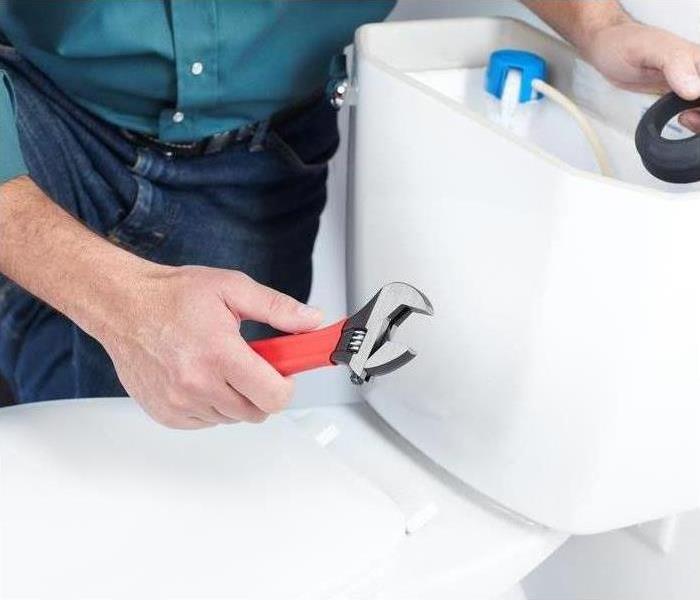 A leaking toilet does not have to ruin your day or consume your weekend.
A leaking toilet does not have to ruin your day or consume your weekend.
Taking Care of Toilet Leaks
Home maintenance in Wilshire Heights, TX is like home maintenance anywhere: a fact of life. A bathroom leak is not an unusual occurrence for homeowners, but addressing it quickly is important to prevent inconvenient and expensive water damage. Whether you are a DIY warrior or a person who prefers to call in the pros, knowing the cause of a leaking toilet can lead to a swift resolution.
The Usual Suspects
Toilets in the average home are not mechanically complex, and this is good news because it makes their repairs fairly predictable. Leaks are often noticed after a flush; if a puddle collects at the base, it could mean that:
- the wax seal has failed or the closet bolts need tightening.
- faulty supply tubes or shut-off valves need replacing.
- the bowl could be cracked or prone to sweating.
The Appropriate Responses
Resolving a leaking toilet can range from a simple adjustment to a complete replacement or anything in between. Once you have identified the problem, the solution is likely to be one of the following:
• If tightening the closet bolts doesn’t resolve the problem, removing the toilet and replacing the wax ring could be necessary. The problem could also be a broken flange, which will become apparent when the old wax ring is removed. A broken flange will require replacement.
• If the supply tube has failed, it is wise to replace it with a flexible, stainless and mesh model. If the shut-off valve has failed, consider replacing it with a new quarter-turn ball valve.
• If the bowl is cracked, replacement will be necessary. If the tank or bowl sweats, installing a mixing valve is a solution many plumbers recommend.
A leaking toilet does not have to ruin your day or consume your weekend. Tackling it yourself or making an informed call to a professional can make fast work of the needed repair.
Why Do I Need a SERVPRO Emergency READY Profile?
3/1/2022 (Permalink)
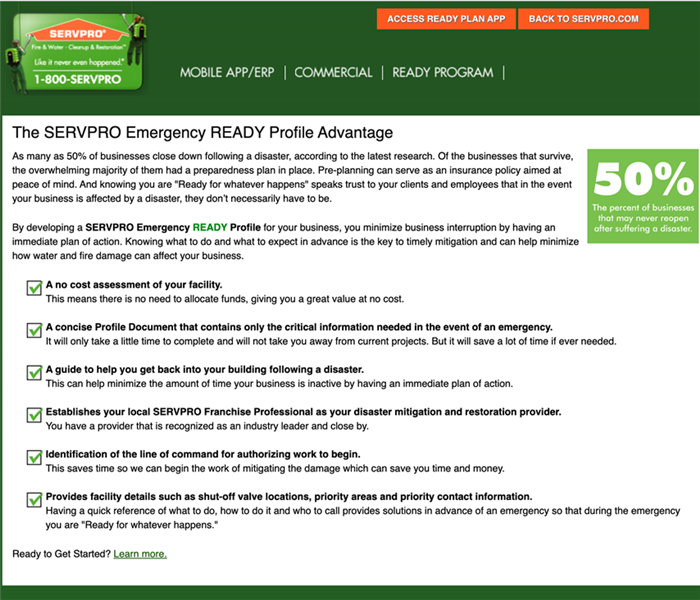 A SERVPRO Emergency READY Profile is an excellent way to minimize your downtime after a disaster.
A SERVPRO Emergency READY Profile is an excellent way to minimize your downtime after a disaster.
Is Your Business Prepared If a Disaster Strikes?
Sadly, for many businesses, the answer is no. Research indicates that nearly half of businesses that are affected by a disaster never reopen. Insurance is important, but it’s not always enough. Creating an emergency profile with an experienced restoration company can give your business a huge advantage if the unthinkable happens.
Why Do I Need a READY Profile?
After a disaster like a flood or fire, most businesses will need to remain closed until restoration work is complete. Every day that your business is closed is not only a day that you aren’t bringing in any money, but it’s also a day that your customers are looking elsewhere and a day that your competition is gaining an edge. Time is of the essence after an emergency, and anything that can help get your restoration underway more quickly can be a game-changer. A SERVPRO Emergency READY Profile is an excellent way to minimize your downtime after a disaster.
What Is a READY Profile?
Developing an emergency profile for your business has many benefits that can save you valuable time after a flood or fire. An ERP does the following:
- Identifies your chosen Oak Highlands, TX, restoration company
- Establishes key business contacts who can authorize work
- Consolidates important information such as insurance policy numbers and contacts into one convenient place
- Stores critical facility facts such as the location of shut-off valves
- Provides a custom action plan with the exact steps you should take in an emergency
How Do I Get Started?
To start creating your READY Profile, first go to SERVPRO.com/ready to register for an account and create a username and password. After you register, you can designate your preferred SERVPRO location and add information about your business. Then, download the ERP App onto your smartphone or tablet, and log in.
Don’t let your business become a statistic. Setting up an emergency profile before disaster strikes will help you reopen as soon as possible.
How To Clean Up a Broken Water Heater
2/10/2022 (Permalink)
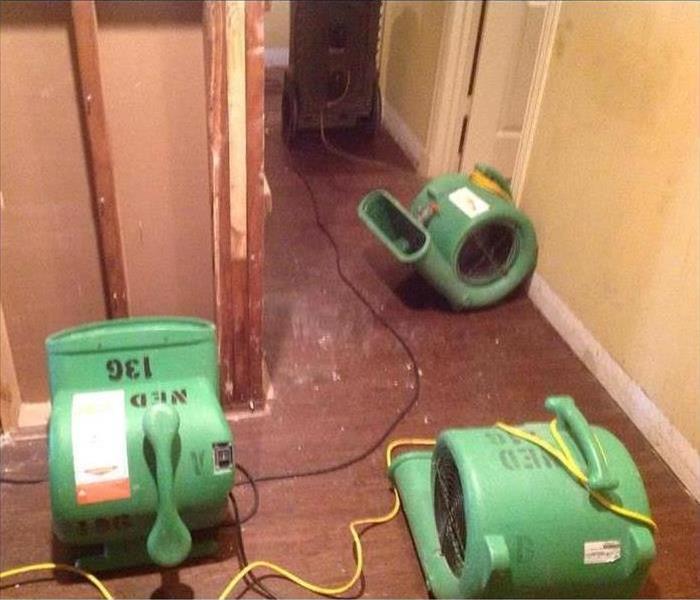 Cleaning up from a leaking water heater in a Wilshire Heights, TX home.
Cleaning up from a leaking water heater in a Wilshire Heights, TX home.
How To Deal With Water Heater Overflow
Having a broken water heater in Wilshire Heights, TX can be dangerous on many levels. While the most obvious threat from a leaking water heater is water damage, the liquid could come into contact with power outlets if not detected quickly, adding fire and electrical hazards to the list of possible dangers. Because they are typically hidden in low-traffic areas of the home, a failed water heater may not be detected for several days, which causes problems to multiply. When dealing with water heater overflow, follow these clean-up procedures to make the process go smoothly.
1. Shut off the water source. If you do not turn off your water while you clean up, not only will it be useless trying to mop up the liquid, it also increases the risk that the water comes in contact with an electrical source. For safety reasons, this should always be the first step.
2. Clean up the water. For small areas, you can probably mop up water with old towels. If your leaking water heater went undetected for a while, you may have a more substantial mess that may require a sump pump or a trash pump.
3. Assess secondary damage. Because mold and bacteria grow best in warm, damp places, a broken water heater can lead to more secondary damage than many other reasons for flooding. The warm water creates an environment that favors mold growth, so it is important to carefully expect any flooring or sheetrock the water came in contact with.
4. Treat mold and disinfect the area. Use an antifungal treatment to remove any existing mold, and then use a disinfectant to thoroughly cleanse the area. Scrubbing the affected spot with bleach and clean water may discourage mold to grow.
Cleaning up from a leaking water heater in your Wilshire Heights, TX home goes beyond simply mopping up the water. Remember to thoroughly clean and disinfect any area affected by your broken water heater.
Prevent a Holiday Disaster: Fix a Leaking Toilet
12/21/2021 (Permalink)
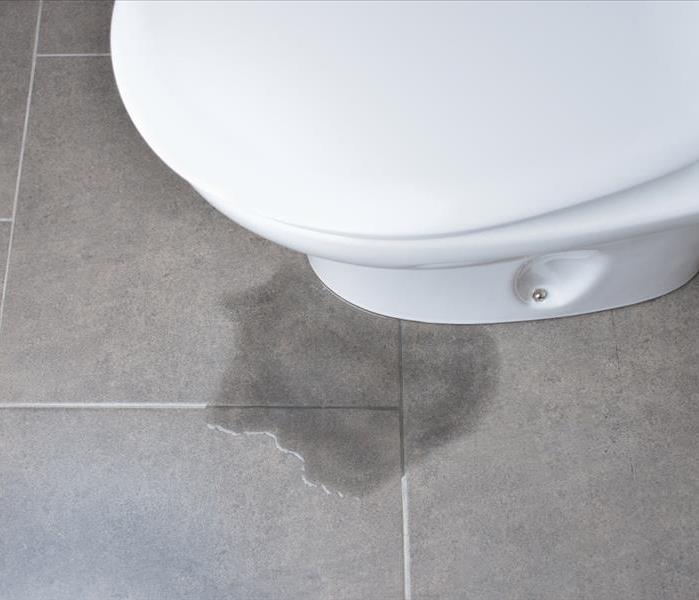 A leaking toilet in Vickery Meadows, TX.
A leaking toilet in Vickery Meadows, TX.
Prevent a Holiday Disaster: Fix a Leaking Toilet
Is your house spilling all its secrets to your holiday guests? Like, literally spilling toilet water? There’s nothing like finding out you have a leaking toilet in the midst of your holiday hospitality. Well, don’t wait until your guests arrive in Vickery Meadows, TX, fix it now!
Confirm the Problem
You may have noticed that your toilet is loose and rocks a little, or that there is water beneath the toilet. These symptoms indicate that a wax seal as the source of trouble for your leaking toilet.
6 Steps To Fix the Problem
Before taking the steps below, check if your toilet just needs better contact with the existing wax ring by gently tightening the bolts. If that does not solve the problem, it’s time to replace the wax ring.
1. Close the supply valve. Flush the toilet to remove water and soak up any remaining water in the tank. Disconnect the supply valve.
2. Remove the toilet. Pop off the bolt caps and remove the nuts. Gently wiggle the toilet and lift.
3. Scrape off the old wax. Here is the reason for your leaking toilet! A putty knife can help clear away the old wax.
4. Inspect the flange. The closet flange is the ring-shaped plastic (or metal) fitting that sits in the drain pipe. It should be flush with the floor and not cracked or broken. Make necessary repairs.
5. Install a new wax seal. Make sure this is centered for proper alignment when you replace the toilet.
6. Replace the toilet. Tighten the bolts and reconnect the water supply.
With your shiny new wax seal and a working toilet, you will be ready for houseguests. You will probably feel good about your accomplishment, too.
Sometimes You Need Help
If you didn’t fix the toilet before the guests arrived and find yourself with a mess, you may need to contact an expert water remediator to help with the bathroom leak. The right company will be available to handle cleanup and repairs, anytime of the year. It may be nice to offer them some holiday cookies, though.
There’s a Geyser in the House: How To Manage a Sudden Pipe Break in the Kitchen
11/25/2021 (Permalink)
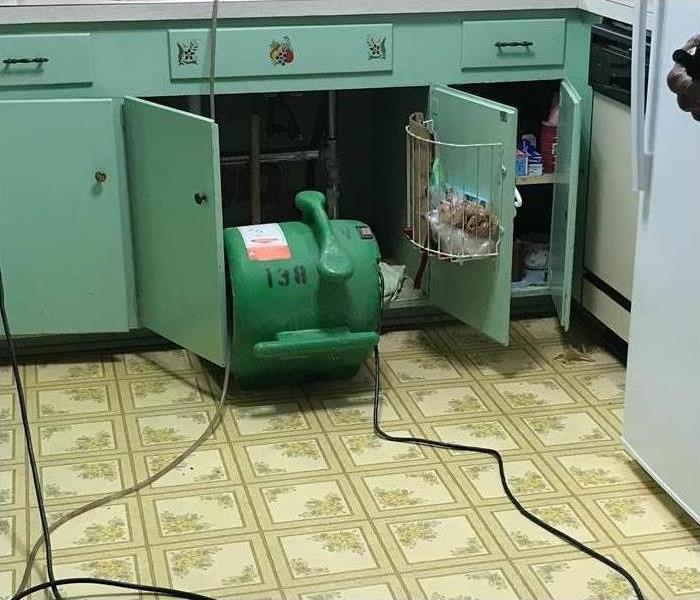 Drying equipment under the kitchen sink.
Drying equipment under the kitchen sink.
Steps To Take After a Pipe Break
You come home to find a geyser in your kitchen causing minor flooding. What do you do? Obviously, you hop on the internet and look for the answer. Well, you’re in luck. Below are the initial steps you should take after a pipe break in your kitchen.
1. Shut Off the Water
To stop a faucet from spewing water in the home, you should immediately shut off the valves under the sink. By turning off the valves, you cut off the water supply and end the unintentional geyser, thereby preventing further water damage. If the supply line is damaged below the shut-off valve then you may want to turn off the main water supply to the house.
2. Call Your Policy Holder
As most homeowner policies will cover flooding caused by broken pipes – as long as the damage was not caused by neglect – you can call your insurer to discuss next steps. Most insurers will require you to file a claim, which will need to be investigated by an adjuster. An adjuster will come to your home, inspect the damage, and make a recommendation to your insurer about any potential coverage.
3. Dry the Affected Area
An adjuster visit can happen quickly, or it can take a week or more. In the meantime, you can mitigate any further damage by drying the affected areas. If the exposure time was minimal, then it may be enough to dry items with mops and towels. If the exposure time was significant, then some tear out may be necessary to ensure adequate drying and to reduce the risk of mold growth.
4. Call a Restoration Specialist
Depending on the exposure time and the extent of the damage, you may want to hire a restoration specialist in Oak Tree Village, TX, for your kitchen repair. If the damage was extensive enough to make a claim then your insurer may require professional repair anyway.
Flooding in your kitchen can be substantial if left unchecked. While it is possible to catch this type of disaster early and prevent extensive repair, the expanse of the pipe break may determine if you require professional assistance, especially if filing a claim.
Easy Fixes for 3 Common Irrigation Problems
9/27/2021 (Permalink)
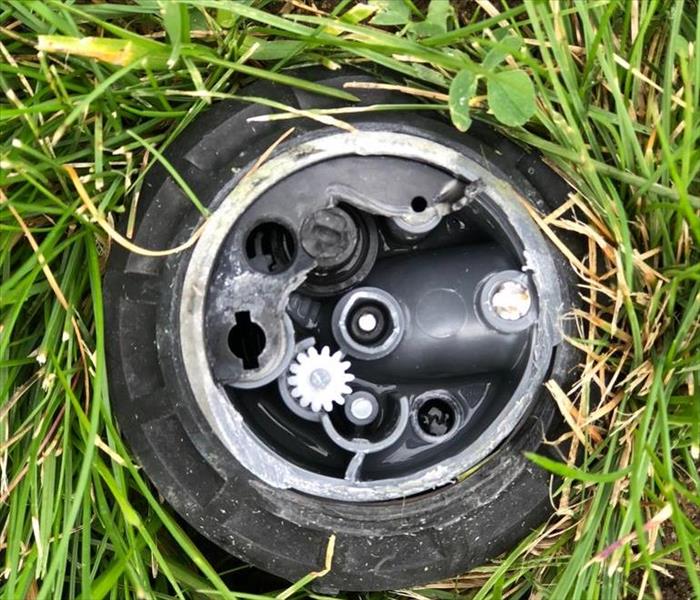 Broken sprinkler head.
Broken sprinkler head.
Three Common Irrigation Problems
When you find water damage in your building in Wilshire Heights, TX, but there is no leaky pipe and not a cloud in the sky, be sure to check your outdoor irrigation system for the source of your troubles. Most commercial properties rely on a sprinkler system to maintain the landscape, but these systems still require some regular maintenance to prevent problems. Learning how to troubleshoot your irrigation network is simple and will save you some headaches.
Remember to shut off the water supply when replacing or fixing parts. The most common problems you might encounter are:
1. Low water pressure. Inspect the irrigation system to make sure all valves are open and all drains are closed. If you still have low water pressure, you may have a leak. Find the source by checking for flooded ground. Lastly, check each sprinkler head from beginning to end, looking for one that is not working well. Gently dig into the ground to check the line that leads to that sprinkler and repair at the site with a fresh cut and a water-tight coupling.
2. Sprinkler heads are not spraying. When a sprinkler is only partially spraying or not spraying at all, investigate for signs of a break or crack first. If broken, simply replace it with a new head. If no break is detected, the head is probably clogged and can be cleaned and replaced. Remove dirt in the area to keep the lines clean when unscrewing heads for replacement.
3. Spray pattern problems. The irrigation system may have a problem with a spray pattern that is hitting a structure on the property or not covering enough landscape. You can make adjustments with a turn of a screwdriver directly in the slot on top of the head.
The most common irrigation problems are simple to fix but can cause big problems when flooding goes undetected and damages your building. Fortunately for you, experienced water damage specialists can handle all your needs from cleanup to restoration.
What Causes a Home To Have Noisy Pipes?
8/16/2021 (Permalink)
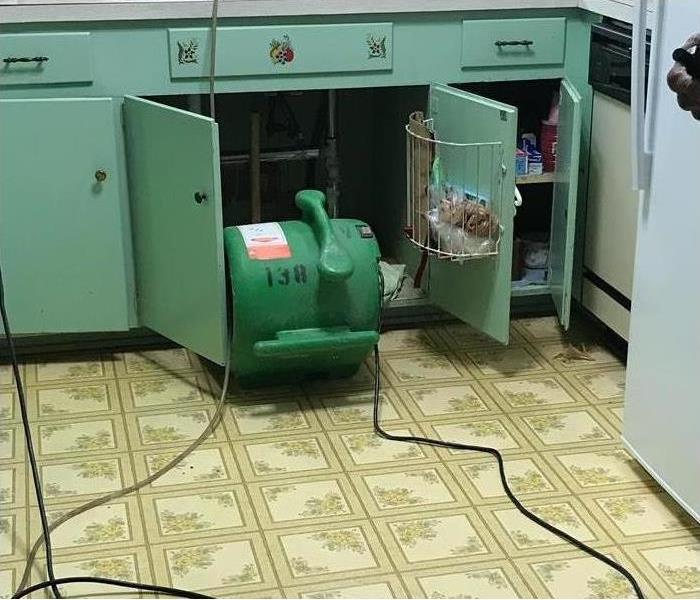 Burst pipes in Lochwood, TX.
Burst pipes in Lochwood, TX.
What Causes Noisy Pipes in a House?
You may be used to all the sounds your Lochwood, TX, home makes each day. You probably know which steps creak and what it sounds like when the house settles in the winter. However, when your home's water pipes start making new or unusual noises, this may indicate that one is about to suffer a pipe break. Since this can cause considerable flood damage, knowing why your pipes are making noise may help you prevent this issue.
Pipe Sediment
Over time, sediment can build up in your home's water pipes that might narrow the path the water flows through. This can be especially common in areas that have a high percentage of lime or calcium in their water. As the pipes narrow, this can cause a whistling sound whenever the water spigots are turned on. Replacing these affected sections may prevent you from having to fix a broken pipe later, when the water can no longer flow through it.
Loose Pipe Straps
If your home's pipes bang or clang when a sink or appliance is turned off, this may mean that the metal pipe straps that secure them to the wall are loose or failing. Since rattling can cause a pipe burst, this is a problem that should be remedied right away. Check interior and exterior pipes, inspect the straps, and replace any that are worn or broken to prevent an eventual pipe break.
Water Heater Needs Servicing
You may sometimes hear a rumbling or crackling sound coming up through your home's pipes. However, this sound is probably emanating from a water heater that has sediment buildup. Over time, sediment can form in the tank and trap some of the water, which boils and causes strange sounds. You can call in a qualified restoration company to flush out and clean the tank so that it runs quieter and with increased efficiency.
Your Lochwood, TX, home's water pipes probably make a variety of sounds you may be used to. However, some of these sounds could indicate an inevitable pipe break, and having them checked out may prevent a costly and damaging flood.
Flushing a Water Heater
7/7/2021 (Permalink)
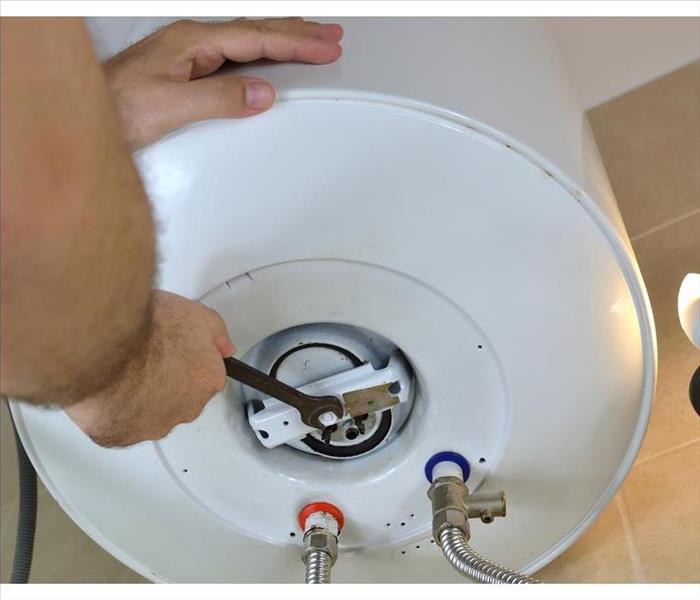 Keep your water heater in tip-top condition.
Keep your water heater in tip-top condition.
At the end of a hard day in Hamilton Park, TX, the relaxation of a hot shower or soak in the bathtub may be just the ticket. It seems fair to say that many homeowners don’t think about their water heaters until they run out of hot water. To keep your water heater in tip-top condition, periodic flushing is a prudent home maintenance move.
Simple Tools and Simple Steps
A garden hose, a screwdriver and a pair of work gloves are likely all you will need to perform a water heater flush. It is important to find an appropriate spot to drain hot water to avoid creating water damage. Five steps can get the job done quickly.
1. Cut the power to the unit. If it is electric, turn off the appropriate circuit breaker. If it is a gas heater, turn off the gas supply.
2. Locate the drain valve and connect the garden hose. Wear gloves and position the outflow to an area that hot water will not damage.
3. Open the drain valve on the water heater and let the water flow out. Open the hot water tap in the kitchen or bath for a few minutes, and then turn off the water supply valve. When the flow of water stops, it is time to turn on the valve again to complete the flush.
4. With the water and sediment drained, close the valves. Turn on the water supply. When the hot water tap in the sink has expelled the air and the stream is consistent, the flush is complete.
5. Before restoring power to the unit, ascertain that the tank is completely refilled with water to avoid damaging the tank or its heating element. Turn off the kitchen or bath tap.
The life of a water heater is hard to predict, but the average is eight to twelve years. An annual flush is likely to help maintain its reliability.
3 Tips for Preventing Water Damage
3/8/2021 (Permalink)
 When you have a water emergency, close your water main shutoff.
When you have a water emergency, close your water main shutoff.
Prevent Water Damage In Your Home
Water is one of the most common causes of damage to homes in the United States. Melting snow and ice, heavy rains, burst pipes and leaky plumbing make water in home a year-round threat for damage. These three tips can help you prevent water damage to your home.
1. Disconnect Hoses in the Fall
Outdoor hoses that are left connected to water sources during the winter can freeze and cause ice blocks that may restrict water flow or cause a broken pipe. To avoid this problem, hoses should be drained and disconnected before winter weather arrives.
2. Learn Where Your Water Main Shutoff Is and How To Operate It
Your water main is responsible for supplying water to your entire house. One of the first things you should do when a water emergency, such as a broken pipe or an overflowing toilet, causes water in home is to close your water main shutoff. This action prevents water from being distributed to the rest of the pipes in your house and stops additional water from leaking into your home. Once you have stopped the flow of water, you can call a water remediation company in Northeast Dallas, TX, to dry out your home. It can also be a good idea to shut off your water when you will be away from home for an extended period of time.
3. Maintain Trees and Other Plants in Your Yard
The roots from trees and shrubs that are too close to your home can grow into or wrap around pipes and cause leaks or broken pipes. Removing these plants from areas near your plumbing is an important part of your pipe cleanup plan.
Water in the home can cause a significant amount of damage. There are steps you can take to mitigate water damage, but it is best to avoid it altogether by following these tips to prevent water damage.
The Categories of Water Damage
2/10/2021 (Permalink)
 Knowing the three categories of water damage is important to the restoration process.
Knowing the three categories of water damage is important to the restoration process.
Water Categories
If your business in Oak Highlands, TX, has an issue with the plumbing such as a supply line problem or burst pipe, you may have many questions about how to keep your building and your employees safe, such as if this is clean water or black water. In these events, it's important to know what type of water damage you have in order to know how to properly begin your building's restoration.
The category of water damage depends on the severity of the water damage, including the level of contamination of the water. Understanding what category of water damage you have is imperative to understanding how to get your building back to its original state as soon as possible.
Category 1
As the water damage categories range in severity, it starts with category one. This is the least severe of the three types. Category one is water that does not contain any contaminants. There are many ways to tell if you have category one water damage, including water damage from any of the following:
- Malfunctioning appliances
- An overflowing sink
- A broken toilet
- Melted ice or snow
Even with clean water damage, the clean-up process is still important to do promptly. Preventing any lasting water damage is imperative to preserving your building.
Category 2
Category two, or gray water, is water damage from water that is contaminated with chemicals or other material. There are many sources of category two water damage, such as water from a broken dishwasher or washing machine, a sprinkler malfunction or a toilet that is overflowing with urine. Gray water can also be a result of category one water from a broken pipe or another water issue, that has been left out too long.
Category 3
Category three, or black water, is the most severe form of water damage. Blackwater can contain bacteria and viruses and can come from sewage, rising seawater, or floodwaters.
Knowing the three categories of water damage is important to the restoration process. It's important to know the difference between clean water, black water, and gray water to prevent lasting damage.
Does Homeowners Insurance Cover Broken Pipe Repair?
11/30/2020 (Permalink)
 Every homeowner should have homeowner’s insurance for residential property in Hamilton Park, TX
Every homeowner should have homeowner’s insurance for residential property in Hamilton Park, TX
Homeowners are often curious whether the cost to fix broken pipe and the damage plumbing problems can cause at a residence are covered by property insurance. Most homeowner’s insurance policies cover sudden, unforeseen problems, but not an outdoor flood or systemic plumbing issues that go unresolved at a home in Hamilton Park, TX.
Check the Policy for Coverage
It is important to know which perils are covered by a particular homeowners insurance policy. Coverage may be available for the following mitigation and cleanup measures:
- Extraction
- Drying
- Pipe repair
Homeowners must be able to prove that no warning signs were present prior to a pipe break to seek coverage for plumbing repairs. Water damage caused by well-maintained pipes is typically a covered peril.
Maintain Plumbing In Your Home
Keeping maintenance records is the best way to maximize the amount of insurance coverage that may be available for any water damage that is not due to flooding or sewer backups. Both of these types of water damage are excluded from most homeowner’s insurance policies and require supplemental flood or sewer damage coverage.
Document and Mitigate Damage
Insurance adjusters rely on a combination of documentation submitted by policyholders and in-person inspections to assess damage. A homeowner has the responsibility to take photos or videos of a property after damage occurs or have restoration professionals document damage.It may be easier to back up a claim if you also have footage of the same areas that predates damage. Mitigation can start as soon as water damage has been documented, even if an adjuster has not arrived on location.
Every homeowner should have homeowner’s insurance for residential property in Hamilton Park, TX. Making sure flood coverage is available, maintaining plumbing and taking a practical approach to documenting damage and pursuing restoration increase the likelihood that insurance will cover more of the total cost of a plumbing damage claim.
What Causes a Wet Crawl Space?
10/12/2020 (Permalink)
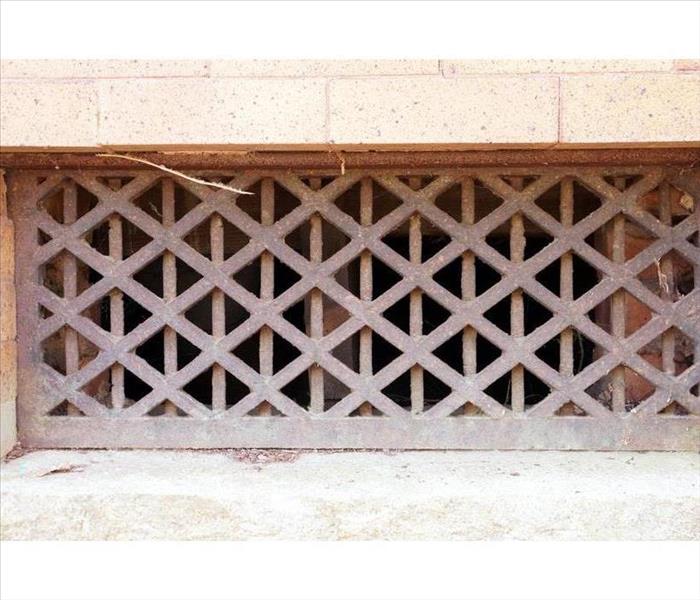 A wet crawlspace is not a primary concern for many homeowners
A wet crawlspace is not a primary concern for many homeowners
Causes Of a Wet Crawlspace
A wet crawl space is not a primary concern for many homeowners who don't regularly think about this part of a house which provides the following functions:
- Protection of a wooden home from the damp ground.
- Insulation from the elements.
- Access to plumbing, electrical, heating, and cooling systems
- Extra storage space.
Unfortunately, many homeowners don't realize that this part of their house is susceptible to flooding, which leads to mold, before it is too late. Understanding why crawl spaces flood can prevent disastrous consequences.
Plumbing Problems
If a line beneath your house ruptures, it can quickly send a deluge of water through the vents of a nearby crawl space. Pipe damage in other parts of your home can also lead to water in your crawl space.
Landscape Changes
The land surrounding your house must slope away from the foundation to prevent gravity from pulling rainwater inside. Excessive rain can very quickly lead to a wet crawl space and possibly cause flooding throughout your home.
Gutter and Downspout Issues
Maintaining clean gutters is vital for keeping water out of your crawl space. When gutters fill with leaves and debris, they can not adequately accommodate rainwater, which can pool on a roof until it overflows into the soil around your house. Once there, it can quickly seep into your home's foundation and crawl space.
Clean gutters with downspouts directed toward your home's foundation can also cause flooding when a constant stream of water into the soil makes its way inside a crawl space.
External Water Lines
Backed up sewer lines can carry water contaminated with sewage into a crawl space. Sewer water in your crawl space must be dealt with urgently. A cleaning company experienced with handling biohazardous material is best suited to manage this complicated situation.
If you discover a wet crawl space in your house in Northeast Dallas, TX, you can rely on a professional cleaning service for help and advice.
3 Ways To Prevent Clogged Toilets
8/17/2020 (Permalink)
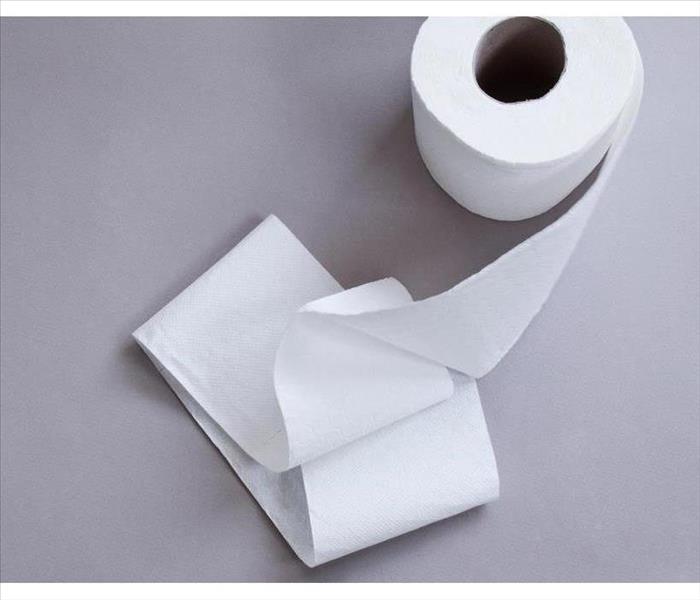 Thinner paper is much less likely to clog up the pipes
Thinner paper is much less likely to clog up the pipes
Take The Following Steps To Help Protect Your Building
Keeping your bathrooms clean and functioning properly can be a hassle in commercial buildings. After all, you never know exactly who is attempting to flush what down your precious septic system. While you may not be able to control many clogged toilet scenarios, there are a few steps you can take to help protect your building in Wilshire Heights, TX.
1. Post Signs and Notices
A few simple instructions can go a long way for most visitors. If you prefer that customers dispose of feminine hygiene products in specifically marked wastebaskets, as opposed to flushing them down the toilet, then hang up a sign asking them to do so. Many people do abide by the laws of common courtesy and a simple reminder can help prevent unwanted toilet overflow.
2. Opt for Thinner Toilet Paper
Thicker, more luxurious toilet paper is preferable for home bathrooms, but it might not be the best choice for your commercial ones. Customers who tend to use thicker wads of toilet paper pose a risk to your sewage system. Thinner paper is much less likely to clog up the pipes.
3. Provide Plenty of Trash Cans and Waste Baskets
If there aren't any trash cans available, customers often choose to flush trash down the toilet. They may believe that it's a much more polite alternative than leaving trash on the counters or floors, but your clogged toilet tends to disagree. Offering plenty of places for customers to discard their trash is a simple and effective way to prevent these accidents from happening.
A clogged toilet is an unpleasant sight in any commercial bathroom. Protecting your bathrooms isn't just about preventing septic issues, it's also important to leave a good impression on your customers. The pointers above can certainly help maintain harmony in your commercial bathroom, but there's no real way to prevent disaster entirely. If you do discover septic issues in your building, it's important that you call flood remediation experts as soon as possible.
Residential Water Toilet Overflow Is More Than a Messy Cleanup
5/22/2020 (Permalink)
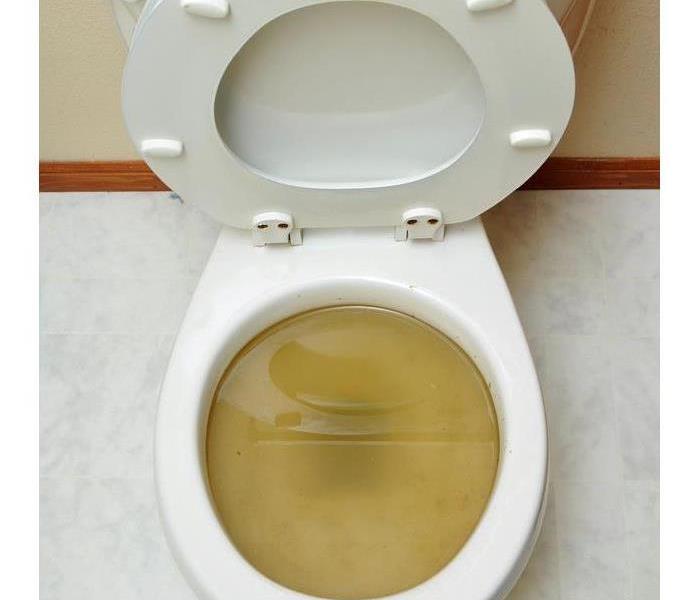 Dealing with an overflowing toilet in your Hamilton Park, TX, home is frustrating
Dealing with an overflowing toilet in your Hamilton Park, TX, home is frustrating
Dealing with an overflowing toilet in your Hamilton Park, TX, home is frustrating, especially if the situation seems to frequently occur. Along with the mess it leaves behind, a flooded toilet can quickly lead to water damage in other areas of the home. As well as potentially being a costly endeavor, repair is made worse by the fact that the toilet could be a sign of a bigger sewer damage issue.
Toilet Problems
In most situations, there are three main reasons for a toilet overflowing:
Clogged Lines: This is the most frequent culprit, and a plunger often can fix the issues. In some cases, the clog may be too far down the line, a situation which may require calling a plumber. Frequent clogs may indicate it is time for a new toilet as well as serve as a reminder to only flush waste and toilet paper.
Blocked Vents: Plumbing fixtures store air and release it when flushing. Debris in vents can quickly lead to clogs that make toilets begin to drain more slowly or stop altogether.
Sewer Issues: The plumbing in your home is connected to the outside world. If the main line to the sewer is clogged or broken, it can cause sewage backup. Along with toilet issues, there may be leaks in the basement or around other drains.
Professional Cleanup
When the culprit is sewer damage, it means that the overflowing water is contaminated and should be handled by a sewage company. Considered black water, it contains potentially harmful pathogens and microorganisms. If the overflowing water had waste in it, it is best to contact a water remediation and restoration expert to handle the problem. Along with having the proper safety gear for the process, they have the know-how to detect additional damage and ensure that the cleanup is done properly. This guarantees your bathroom and affected areas are safe and clean.
While a toilet issue may seem like something that is easy to deal with, checking that there is no sewer damage is imperative before diving into cleanup.
The Water Mitigation Process in Commercial Properties
5/7/2020 (Permalink)
 Water restoration in a Wilshire Heights, TX building
Water restoration in a Wilshire Heights, TX building
Water Mitigation Process
A pipe burst cleanup in a commercial property is a significant undertaking. Seek mitigation specialists to help with the mitigation and restoration of the property. Water restoration companies in Wilshire Heights, TX, may follow the same six-step restoration process.
- Shut down the water supply
- Mitigate further loss
- Remove excess water
- Discard Debris
- Clean and disinfect
- Restore the property
Shut Down the Water Supply
While a burst does not always occur, even supply line leaking can cause damage if not corrected. Locating the source of the leak and shutting down the water supply is one of the first things a restoration company will do on the scene. Quick intervention reduces the extent of damage to the building.
Mitigate Further Loss
After cutting the water supply, the restoration company may suggest ways of mitigating further loss and protecting your potential insurance claim. Board-ups and tarp-overs are the two primary ways of protecting your property.
Remove Excess Water
After mitigation, a pipe burst cleanup begins with removing excess water from your building. A crew may use shop vacs, pumps and dehumidifiers to make your space as dry as possible during the water cleanup.
Discard Debris
After the removal of excess water, the team will begin gathering and discarding debris. Don't worry. You are part of the sorting process. If there are salvageable items, you may need to use specialty cleaning services to restore the items.
Clean and Disinfect
With the area clean of any debris or clutter, the mitigation company you hire will begin cleaning and disinfecting the property. Depending on the materials and surfaces affected, the crew will use various cleaning solutions and machines to help prepare your facility for restoration.
Restore the Property
The last step of the restoration process is the construction phase. Engineers and team members will reconstruct the affected area to pre-disaster conditions.
A pipe burst cleanup is a massive undertaking, so don't go it alone. Hire a restoration company to help.
Minimizing Flood Risk for Your Home
2/17/2020 (Permalink)
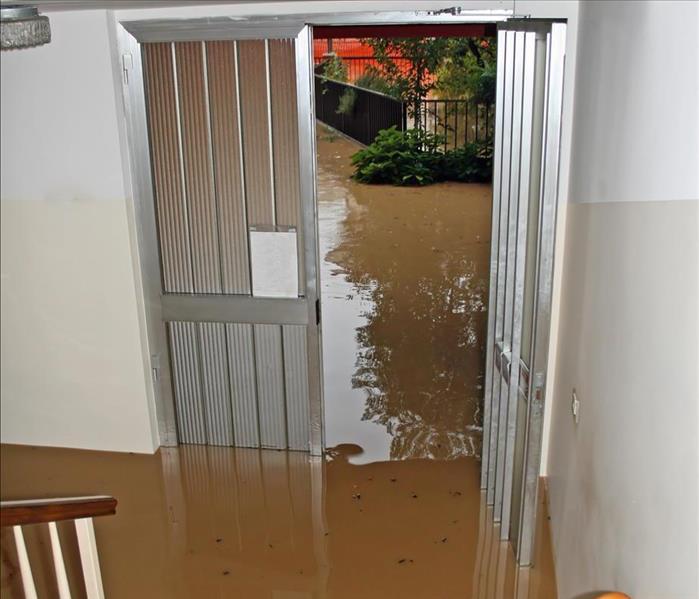 Flood damage in Northeast Dallas, TX
Flood damage in Northeast Dallas, TX
Water damage due to flooding is in the top three reasons for homeowners’ insurance claims. Many homeowners don’t realize how common it is to have a first-level or basement flood. This summary of flood risk and flood prevention may help you reduce your risk level.
Common Sources of Home Flooding
The following flood dangers are a few of the ways water can make its way into your home and cause damage:
- Internal sources such as broken pipes or leaking appliances
- Rivers or streams overflowing during severe storms
- Sump pumps failing
- Municipal failures, such as water main breaks and dam breaches
- Drainage malfunctions during severe storms
Whatever flood culprit threatens your home, it’s important to minimize your risk. Determining your home’s risk level is the first step.
Reducing Your Home Flood Risk
The best strategy for reducing your risk of a ground-level or basement flood is to arm yourself with information and preparation. A flood risk assessment for your home will tell you whether you should have flood insurance and will allow you to design a custom emergency preparedness plan. Your local flood remediation service or insurance agent can arrange a risk assessment for you.
If your property bears even a moderate risk for flooding, it’s prudent to purchase a flood insurance policy issued by the US Government. Your conventional homeowner’s policy will not cover home water damage unless the source of the flooded area was inside your home; if a water heater leak caused a basement flood in your Northeast Dallas, TX, home, your homeowner’s policy would likely cover you.
Based on your risk assessment, you can create a comprehensive flood prevention plan. In general, it’s a smart idea to schedule a walkthrough of your home with your family to identify emergency evacuation routes and discuss your plan. Signing up for local and national emergency notification services is also a good precaution.
A home flood risk assessment is your template for your emergency response plan. Creating and implementing the plan can mean the difference between a little water in the corner of your basement and extensive water damage.
Should I Update My Plumbing System?
1/30/2020 (Permalink)
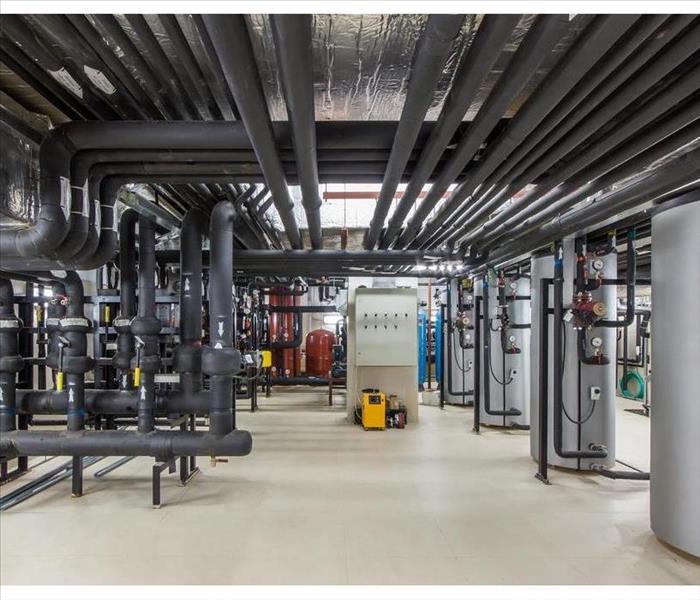 Building plumbing system in Oak Tree Village, TX
Building plumbing system in Oak Tree Village, TX
Should I Update My Plumbing System?
If your Oak Tree Village, TX, commercial property was built or repiped sometime between 1978 and 1996, there’s a good chance that it has polybutylene pipes. What once was hailed as a great new plumbing technology eventually turned into a bunch of burst pipes and flooded properties. Then, polyvinyl chloride (PVC) was introduced. So, which is the best decision, keeping the old pipe system and risking a disaster or paying to repipe the building with PVC? The old pipes:
1. Degrade
What they didn’t realize about the material of this type of pipe is that it degrades over time. Water treatment chemicals, such as chlorine, can break down the material making it brittle. Over time, mini-fractures will form in the pipe, eventually causing it to rupture under the water’s force. Unfortunately, there’s no way to detect a problem with the pipe since the deterioration starts from within the pipe.
2. Affect the Water
Brittle, degrading pipes can affect the quality of the water. Chemicals can leach into the water.
3. Aren’t Repairable
There’s no way to repair a damaged polybutylene pipe since it degrades from the inside out. Replacement is your only option to protect your building.
4. Aren't Up to Code
Building codes in the United States and Canada no longer recognize these pipes. If you want your building to be up to code, you’ll have to get your building repiped with PVC.
5. Won’t Be Covered by Insurance
More than likely your insurance won’t cover your building if it has these old pipes. At the very least your insurance premiums may be a lot higher than they would be with newer pipes.
6. Lower the Building’s Value
No one is going to want to buy a building that’s not up to code. If they do, it’s going to probably be for a lot less than your building is worth. Getting your building up to code will make it much more appealing to potential buyers when it’s time to sell.
Getting new plumbing for your building could get expensive. If your building sustains water damage due to degraded polybutylene pipes, restoration professionals can return it to its preloss condition.
Does Insurance Cover a Basement Flood?
12/10/2019 (Permalink)
 Your homeowner’s policy will likely cover a portion of the cleanup and restoration cost of your basement flood
Your homeowner’s policy will likely cover a portion of the cleanup and restoration cost of your basement flood
All too often a homeowner goes downstairs, only to find standing water in their basement. If you have a basement flood in your Vickery Meadows, TX, home, you are tasked with interrupting your busy schedule to clean up a big mess, protect your property and investigate whether any insurance coverage is available for your damages.
Home water damage is covered under two areas of insurance. The source of the water determines which type applies. Most forms of water damage will be covered by your homeowner’s insurance, though there are exceptions. This discussion about water-damage insurance may help you pursue the proper channels.
What Your Homeowner’s Insurance Covers
Your homeowner’s policy will likely cover a portion of the cleanup and restoration cost of your basement flood, as long as it wasn’t the result of rising external floodwaters. The following scenarios would likely be covered by your conventional policy:
- A leak through a damaged roof
- Stormwater entering a window broken by hail
- Leaking appliances, such as a water heater or washing machine
- Broken or leaking pipes
- A leaking or overflowing toilet
Your insurance agent can go over the details of your coverage and help you file a claim. It’s important to inquire about deductibles and limits as they can vary between policies.
What Homeowner’s Insurance Will Not Cover
If your basement flood was caused by an actual flood, your homeowner’s policy would generally not cover it. A flood is a temporary condition where normally dry land is inundated by water or mud. If this situation caused your flooded basement, coverage would be provided by a separate flood insurance policy issued by the government.
To recover damages, you would have had to purchase a policy prior to your flood event. Flood hazard maps are used to determine your level of risk. You may have been required to purchase flood insurance if your property is shown to bear risk.
When water damages your home, you have many items to handle. Assessing the possibilities for insurance coverage will undoubtedly be among your concerns. This discussion may help you streamline that process and restore your property and your peace of mind.
Tips for Snaking a Drain
10/24/2019 (Permalink)
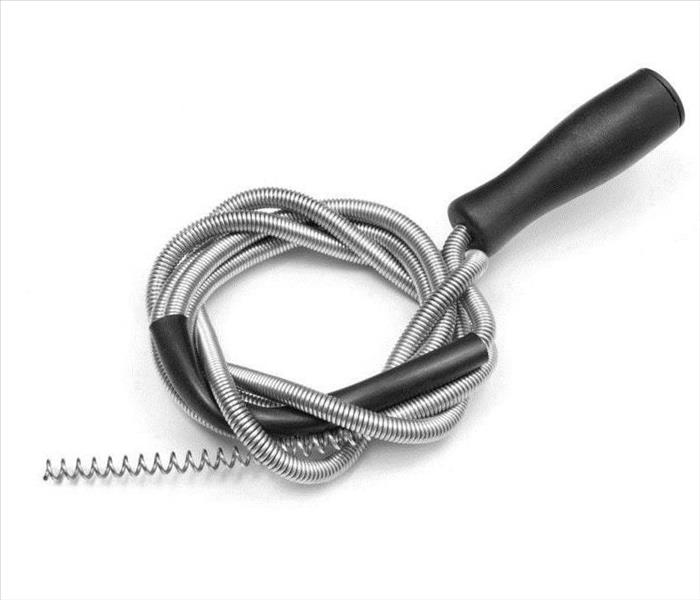 If you know how to snake your drain properly, though, it can also be an easy fix.
If you know how to snake your drain properly, though, it can also be an easy fix.
Tips for Snaking a Drain
If you have a clogged shower or sink in your home in Oak Highlands, TX, it helps to have a plunger handy. Sometimes, however, the plunger doesn't do the trick. If you have a clog that you can't plunge clean, try using a drain snake. Here are a few tips for using one effectively.
Identify the Cause
It's helpful if you know what is clogging your drain before you stick the auger down in it. If it gets too compacted, it could weaken the pipe and eventually cause a pipe break. There are several common causes of clogs:
- Hair
- Greasy food particles
- Soap residue
- Mineral buildup
Solid objects may offer resistance to the auger until they're broken up, allowing them to be pulled out. Loose particles may break up and simply wash down the drain.
Thread the Auger Firmly
Insert the auger and slowly crank it to move the snake down the drain. You don't want to jam the auger quickly into your clogged pipe, but don't be surprised if you have to apply a little pressure to get it past the pipe's bend. You may also need to apply pressure to break up the clog once the tip of the snake reaches it.
Test With Water Blast
Water remediation experts recommend that you test to see if the drain is open after you have snaked it to avoid an overflow. Even if you are able to pull out the objects that have stopped up the pipe, you still need to test to see if the job is done. Turn the water on as high as it will go to flood the pipe. If the clog is gone, it should drain quickly and easily. If the water takes a long time to go down the drain, try snaking the drain again.
A clogged pipe can be a nuisance. If you know how to snake your drain properly, though, it can also be an easy fix.
How To Prevent Broken Pipes While on Vacation
8/22/2019 (Permalink)
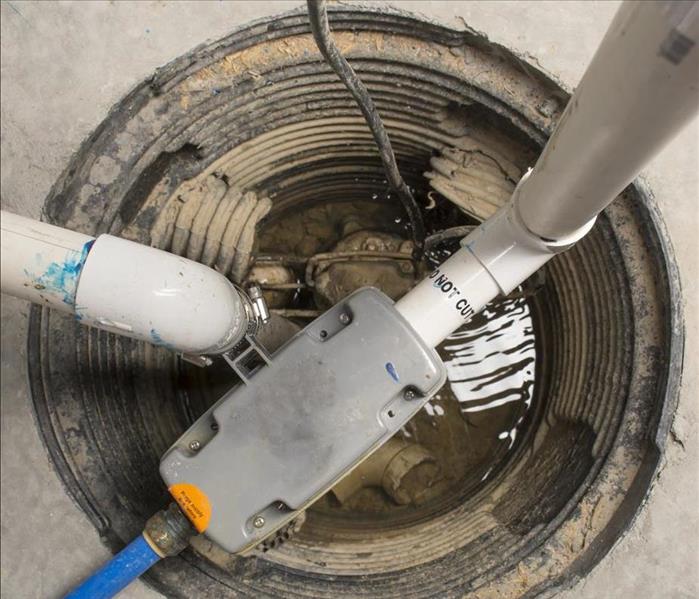 Examine the sump pump
Examine the sump pump
Vacation is supposed to be a time of relaxation, not one that has you receiving a call to head home to Lochwood, TX, and plan for a water pipe repair job. If you want to relax while you're spending a week away with family, you can take steps to prevent a broken pipe from occurring while you're away from home. Simply have a professional perform a full inspection before you leave.
Check All the Pipes
The first thing your inspector should do is check your pipes, windows, and water heater for leaks. He or she will look in several places:
- Under the bathroom sink and tub
- Behind the toilet
- Under the kitchen sink
- Around all the windowsills
- Behind and around your water heater
If leaks are found, your inspector will either reseal them immediately or recommend someone to perform more extensive repairs.
Examine the Sump Pump
If your sump pump hasn't been inspected in a while, you'll also need to have someone examine it. A professional can ensure there is no chance of it causing your property to become flooded by examining its overall condition, clearing it of debris, and detecting and repairing issues that create strange sounds. The examiner can also install a battery backup in case of a power outage while you're on vacation.
Have Someone Check on Your Home
Finally, while you're away, it is important to have someone keep an eye on your house. Provide a trusted family member, friend, or neighbor with the keys to your home so he or she can check on things. This is especially important during cold weather that could cause pipes to freeze and burst. Your house sitter should also have directions to follow in case you do need water pipe repair.
A broken pipe at home can lead to a less-than-exciting vacation. By preparing your home before leaving, you help to ensure your time away isn't interrupted by an unexpected problem.
FAQs About Wet Building Materials
6/10/2019 (Permalink)
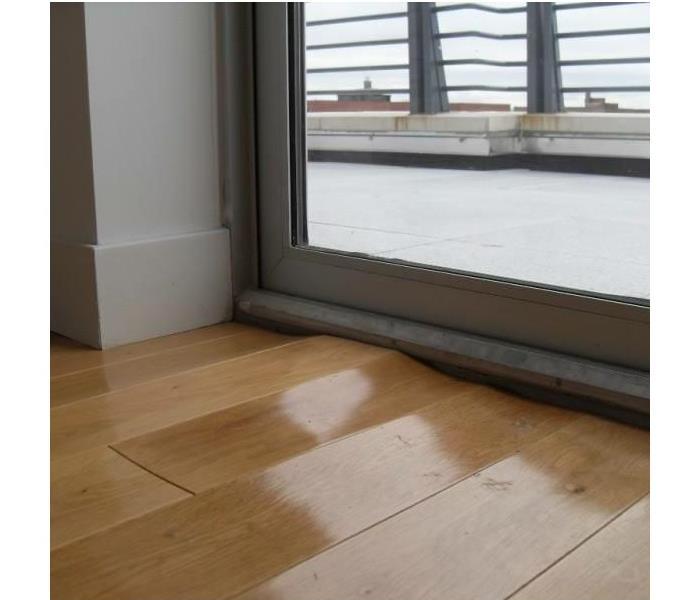 Swelling wood can occur if water is left to sit for an extended period of time
Swelling wood can occur if water is left to sit for an extended period of time
When your home in Urban Reserve, TX, has flooded, a variety of elements in your home are likely to be affected. Though dealing with swelling wood, damp drywall and other issues may seem overwhelming, it can be useful to understand the impact water can have on building materials.
What Building Materials Are Affected by Flooding
Depending on the extent of the damage in your home, different materials can be affected. However, materials that are often affected by flooding include:
- Drywall
- Laminate
- Carpet
- Wood
What Types of Damage Occur?
Different materials have different reactions to water damage. The source of the water can also affect the type of damage that occurs, as clean water from a supply line will generally cause less damage than water that is contaminated with hazardous materials. Items such as carpet floors or drywall are likely to sustain mold damage in a short period of time, especially if the water is contaminated. Swelling wood can occur if water is left to sit for an extended period of time, and subfloors and laminate floors may become warped.
What Items Can Be Restored?
When you know what building materials can be restored, it’s easier focus on repairing the broken water heater or making a water pipe repair. It is often possible for water damaged items to be restored, though it’s important for restoration to begin quickly after the damage has occurred. Wooden floors and other materials that are made out of real wood can generally be saved and restored. However, laminate floors and subfloors often need to be replaced. In order to ensure a timely, efficient restoration occurs, it can be helpful to employ a company that specializes in water damage repair.
Though flooding can result in swelling wood and mold growth, it’s helpful to know which issues are worth the stress and which issues can be fixed. Overall, knowing how floodwater can affect your home can help you to feel more prepared for the process of restoration.
How To Stop a Commercial Toilet From Flushing Repeatedly: 3 Steps
4/18/2019 (Permalink)
 Knowing how to maintain the unit can lower the risk of floods and the damage they cause.
Knowing how to maintain the unit can lower the risk of floods and the damage they cause.
Actions To Take When Commercial Toilet Flushes Repeatedly
If you own a Lochwood, TX, business, then your building likely contains one or more restrooms for employee and customer use. Maintaining commercial toilets are usually simple, as they run on a device called a flushometer that helps the units flush effectively. However, when these devices malfunction, it may cause a toilet overflow and flood damage. If you are dealing with such a problem, there are a few actions you can take to resolve it.
1. Open the Flushometer
Once you turn off the water supply to the toilet, you will have to open the flushometer to expose its inner workings. Use a wrench to undo the outer lid. Once this is loose enough, you can lift it off to expose the flushometer’s flange cover. Take a moment to ensure the water is completely shut off, or you may be dealing with an additional toilet overflow otherwise.
2. Clean the Gasket and Weep Hole
Once common cause of a commercial toilet flood is sediment buildup around the unit’s flange, which may also be blocking the weep hole. This hole allows water to drain out of the flange; however, when it stops working correctly, the flange can no longer form a tight seal. Once this occurs, it can be difficult to stop a toilet from flushing itself repeatedly. You may be able to resolve the problem by thoroughly cleaning away sediment and other buildup and ensuring the weep hole’s port is not blocked.
3. Reassemble the Unit
Once you have cleaned all the parts of the flange, replace it and screw the cover back on. Test the toilet with a flush and watch to see if it fills and shuts off. If it does not operate properly and you are concerned the unit will overflow again, call in a flood control and restoration service to inspect the lines and the toilet itself, which may prevent any moisture damage to your restroom’s floor.
A toilet that flushes repeatedly can cause increased water bill costs and toilet overflow problems at your Lochwood, TX, business. Knowing how to maintain the unit can lower the risk of floods and the damage they cause.
Do You Have Water Dripping From a Light Fixture?
3/15/2019 (Permalink)
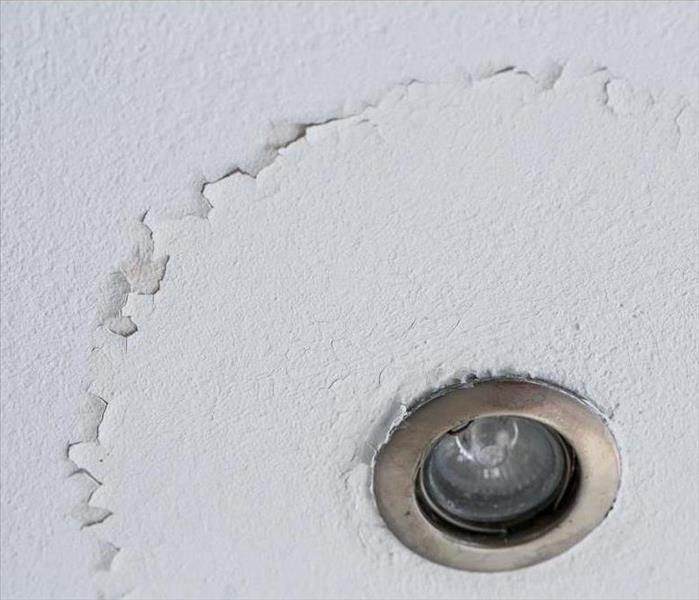 Water damage on a light fixture in a Dallas,TX home
Water damage on a light fixture in a Dallas,TX home
How to Fix Water Dripping from a Light Fixture
Water dripping from the ceiling is a serious and yet all too common problem. When that ceiling drip turns into water in a light fixture scenario, the situation can become hazardous. That is because electricity and water can be a dangerous combination. To ensure your family’s safety in Dallas, TX, call in a water mitigation team. While you wait for the team to arrive, there are four steps you can take to help get the job done quickly.
1. Utilities
Make sure the electricity, gas and water are turned off to the area affected by the leak. Water can conduct electricity from an active electrical line, and that can become a very dangerous situation as the current flows through the metal parts of the light fixture.
2. Announcing
Make an announcement to everyone in your home that there is water in a light fixture. You should probably also let them know the gas, water, and electricity will be turned off for an unknown number of hours. Once the water mitigation team arrives, and the source of the leak has been found, you can make another announcement regarding the required shutoff time.
3. Draining
Ceiling damage from water can sometimes pool and cause a protrusion in your ceiling. If that is true in your case, you may consider draining the area. With a bucket in hand, softly pierce the center of the sagging ceiling bulge with an item like a small wooden dowel. Be prepared for a deluge from the tiny hole.
4. Cleaning
Not only is it important to remove the water from the floor, but you may find it necessary to keep additional water from hitting your newly cleaned surface. Use a bucket to catch the leaking water if it is still dripping, and place towels around as necessary.
If the leaking water in a light fixture fell onto the carpet, you can make a request that your water mitigation team handle the water removal and disinfecting of the flooring area. Once repairs have been made, your home should be good-to-go.
3 Ways To Immediately Handle Sewage Damage in Your Home
1/18/2019 (Permalink)
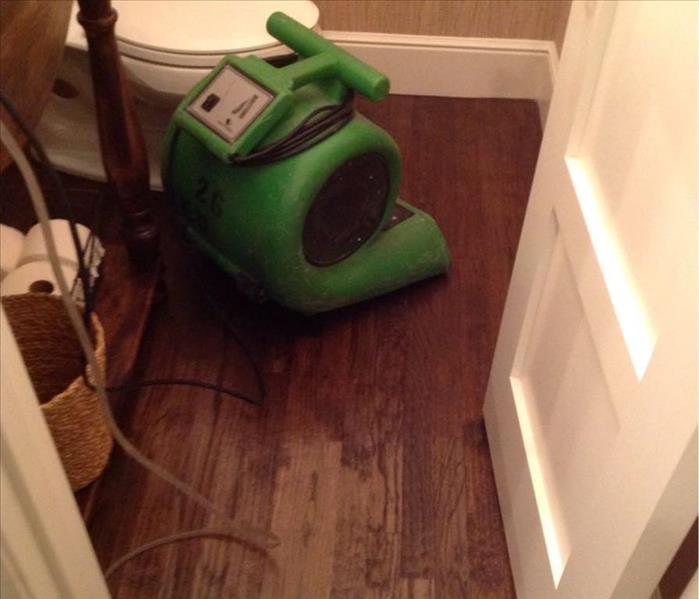 Air mover releasing some bad odors after a sewage damage in a Dallas, TX home.
Air mover releasing some bad odors after a sewage damage in a Dallas, TX home.
There are a number of things you’d prefer to never have to deal with in your Dallas, TX, home, and one of them is finding sewage damage. Whether you’ve come across a stubborn flooded toilet, a clogged drainage system or a full-blown flood from sewer backup, the end result is never pretty. If you’re wondering just how to go about treating and disinfecting your residence, here are three ways to instantly start managing sewer cleanup in a safe and responsible manner.
1. Avoid using the water supply system in your home if the damage is overwhelming.
You may be used to the occasional backed-up sink or toilet. However, if the damage is severe and the clog or disruption hasn’t been cleared yet, attempting to use any water in the home can result in even more destruction. It’s best to contact a professional team of water damage restoration specialists equipped to handle not only the immediate cleanup, but the necessary sterilization procedures afterwards to ensure your home is left safe and habitable.
2. If it’s still safe for you to be inside your home, wear protective clothing near the damaged areas.
When sewer cleanup is underway, keep your body covered in protective clothing and gear in order to prevent any contact with dirty, possibly-infected water. Items such as goggles, rubber boots and gloves are best for keeping your skin and eyes covered, while a basic face mask can prevent you from breathing in any toxic fumes.
3. Open your windows and utilize fans to air out the obtrusive smell.
While experienced restoration specialists are Here to Help and are prepared to deodorize your home before their job is done, you can help release some of the bad odors by using fans and keeping your windows open throughout the day.
Be Ready for Any Stinky Situation
Dealing with sewer cleanup in your Dallas, TX, residence is never fun or easy, but with these ideas in mind to help recover after the fact, you’re one step closer to getting over the event as quickly as possible.
What to Know About Frozen Pipes
12/23/2018 (Permalink)
 Cold temperatures can lead to frozen pipes and cause damage in your Urban Reserve,TX home
Cold temperatures can lead to frozen pipes and cause damage in your Urban Reserve,TX home
The cold temperatures of Urban Reserve, TX, can lead to a number of problems for homeowners. One of which may include frozen pipes. A hard freeze can even lead to broken pipes or water damage in your home. Here are some things you may want to know about what to expect when your pipes freeze.
What To Do When Pipes Freeze
If you have a frozen pipe in your home there are a few things you can do
- Call a professional for help
- Keep your pipes open so the water has a place to go when thawed
- Apply gentle heat, like a hot towel or blow dryer, to the frozen area of the pipe
Why Pipes Freeze
During a hard freeze the temperature outdoors can drop so low that the cold can permeate the pipes. Any water inside will then expand. If there is not enough room inside the pipes, then the pressure can cause cracks which will lead to leaks when the water thaws. A water damage professional can help with repairs to your home if the leak causes damage.
Preventing Frozen Pipes
Fortunately, there are a few prevention steps you can take to prevent the freezing of your pipes and subsequent water damage. These steps include draining the water from pipes that may freeze such as a sprinkler line, and disconnecting any hoses from your home. You may also want to close any indoor valves that supply water to outdoor lines. If the weather is especially cold you may want to let your faucets drip a little as moving water is less likely to freeze. It’s also a good idea to keep your home’s temperature above 55 degrees.
When a hard freeze occurs, the water in your pipes can freeze and cause some damage to your home. A professional can help with any repairs and cleanup you may need. If you know that the temperature is likely to get to freezing point, you may be able to take some steps to protect your pipes.
Preventing Water Damage During a Vacation: What You Can Do
10/10/2018 (Permalink)
 Shut off your water at the main shut off valve to your Northeast Dallas,TX home before going to vacation.
Shut off your water at the main shut off valve to your Northeast Dallas,TX home before going to vacation.
If you are going on vacation soon, you may be worried about what could happen if your Northeast Dallas, TX, home floods while you are away due to a water leak. You should try not to get to stressed out about this concern - there are several things you can do both to defend yourself against a flood and understand what options for remediation you would have if water pipe repair was required.
Prepare Yourself
If you know you are going to be away for some time, there are several things that you can do to help protect your home from a water-related disaster. Some of these actions include:
- Asking a friend, neighbor or family member to watch your house.
- Insulating external pipes (if it is cold outside).
- Cleaning and inspecting your sump pump, water hoses and gutters before you leave.
- Checking for leaks in water-based areas around your home.
- Turning off your water right before you go.
Taking action by following the advice above can help you avoid a flood and water pipe repair when you get home from your getaway.
What Might Happen
If a broken pipe floods your house while you are away, you may come home to find structural damage to various parts of your home. These could include floors, bathrooms and furniture, to name a few. Depending on how long the water has been sitting, it may be contaminated and require speedy removal.
Help is Available
You will hopefully be able to avoid a flood issue completely by following the preventative measures above. However, if you do come home from a relaxing trip only to find a flooded mess that will require water pipe repair, you will likely need to seek help from a water damage company, especially if highly contaminated water is involved. They will be able to understand what happened and what needs to be done to get everything back to a normal state as soon as possible.
Tips and Tools To Clear the Clog
6/22/2018 (Permalink)
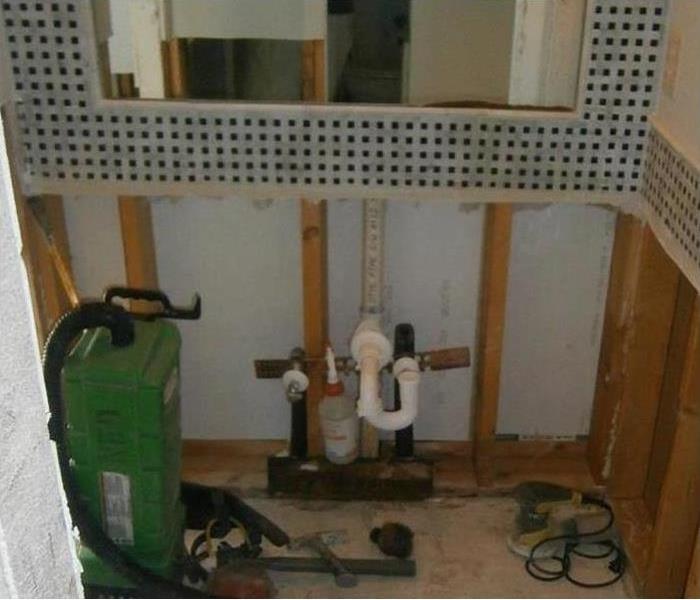 Toilet backup and the damage it caused.
Toilet backup and the damage it caused.
“The toilet is clogged,” shouts someone in your family. Your first thought is to call a plumber out to your home in Northeast Dallas, TX. However, that is not always needed. Easily tackle this job yourself with the right tools, knowledge and a short trip to the hardware store.
What Tools Do I Use?
There are many types of tools to quickly and inexpensively fix a stopped toilet, sink or bathtub drain. Understand the differences between them:
- A plunger is your first line of defense, as it is a cheap and fast way to clear a clog. It is a good idea to keep one in the house at all times for emergencies.
- If the plunger does not work, use a cable auger. Otherwise known as a snake, this coiled, flexible tool is available in different lengths and reaches clogs further down the pipe.
- Use a closet auger specifically for toilets. The curved and solid design of this snake lends itself to fitting into the bowl.
- For an especially tough clog, buy or rent an electric power auger. This impressive snake easily powers through blockages without relying on your strength to turn the handle.
What Steps Do I Take?
If the plunger does not work, use the drain auger in the following ways:
- For a sink, remove and check the sink trap for obstructions. Thread and turn the snake clockwise through the drain pipe in the wall. Crank until the clog is free, reattach the pipe and run the hot water.
- In a stopped up bathtub, remove the overflow plate, feed the snake through and turn clockwise until the clog is clear. Replace the plate and run hot water down the drain.
- For a clogged toilet, place the curved end of the snake into the bowl, push and twist clockwise until clear and flush the toilet.
When you invest a small amount of time and money on the correct tools, you become the expert of clogged drains at your house in Northeast Dallas, TX. However, if you notice water damage or indications of a pipe break immediately call a water restoration specialist to assess the situation.
For more information please visit us at http://www.SERVPROnortheastdallas.com/.
3-Step Action Plan for a Flooded Furnace
4/11/2018 (Permalink)
Dealing with a furnace flood as the result of a burst pipe in Northeast Dallas, TX, can feel like an all-encompassing task. Divide the process into three manageable steps to decrease anxiety, increase efficiency in the claims process and get your business up and running again.
1. Document Damage
The furnace is most likely your top priority. However, it’s important to also note other property damaged in the area. Use the following process to document losses and assign values in a notebook or spreadsheet.
• Photograph the damage.
• Write down the serial number or another unique identifier if available.
• Assign a value.
Don’t forget to include items that may have no monetary value but are still of high value to your business. There are professional recovery services that may be able to save these irreplaceable items such as documents or photographs.
2. Investigate Coverage and Decide To Repair or Replace
A burst pipe resulting in a furnace flood is often an insurable event, so make sure to check with your provider. The AHRI recommends replacement versus repair of a flooded furnace. Property owners may receive advice that the furnace will work again after a total dry-out and perhaps some minor electrical repair. This is often the case and good news if the furnace isn’t covered. However, the life of the unit may have been reduced. You likely don’t want to choose repair over replacement and have a related problem surface a couple years later, long after the claim has been closed.
3. Care of Air Ducts
The quality of air from a furnace is often only as good as the ducts it travels through. Your final task is to schedule a professional air duct cleaning to ensure ducts are clean, dry and free of mold and debris.
Tasks associated with a furnace flood are something nobody wants on their to-do list. Take this systematic approach to efficiently ensure the return of a safe and comfortable environment in your commercial property in Northeast Dallas, TX, for years to come.
For more information, please visit us athttp://www.SERVPROnortheastdallas.com.
3 Ways To Deal With Water Damage
3/19/2018 (Permalink)

It is important to care for items that have been damaged by water. No matter if a broken pipe, appliance, or backed-up toilet is the culprit, it is important to fix the source of the leak and carefully care for any vulnerable items in your home as soon as possible. If you wait a long time, these items may degrade or even begin to mold. Depending on the type of items that were exposed and the extent of the water damage, you may want to consult experts on water in the home who provide dry cleaning services in Dallas, TX.
Whether you think you can handle the water damage yourself or you want to start the cleanup process while you wait for the experts to arrive, here are three general guidelines for handling items with water damage.
1. Gently clean and rinse items that are still wet. Try not to grind debris into the surface. Be especially careful when handling delicate items such as art, paper, photographs, or other fragile materials. These should be removed from walls or any folders and containers and allowed to air dry.
2. Air dry objects indoors to avoid causing additional damage with sunlight or heat. Direct sunlight can compound the damage resulting from water in the home and lead to splitting, buckling, or even warping items and furniture.
3. Increase airflow and decrease humidity as much as possible to speed drying and prevent mold from forming.
If you are dealing with water in the home after a broken pipe or another kind of leak, you should focus on drying and airing out the affected area as quickly as possible. In most cases, it is best to lay out damp items indoors and circulate and dehumidify the air. Skilled restoration experts in Dallas, TX, may also be able to answer any of your questions if you are concerned about whether you can safely clean or dry a delicate item.
How To Restore Your Belongings After Water Damage
1/31/2018 (Permalink)
Water in home settings can be devastating, whether it comes from leaking pipes or backed-up drains or toilets. While there may be nothing you can do to prevent your items from becoming waterlogged in the event of an unexpected water leak, there are some things you can do to restore your belongings after water damage occurs. Here are a few ways you can clean up various items in your Dallas, TX home.
1. Separate Items
Before you officially begin the cleanup process, separate your items into those that are porous and nonporous. Porous materials may include wood, paper, rugs and other types of fabric. Generally, these are more likely to harbor mold and bacteria from broken pipe water, so it’s important to clean them quickly. Nonporous items are usually much easier to clean, since they don’t absorb water and are less likely to harbor bacteria and mold.
2. Dry-Clean Non-Porous Items
Dry cleaning may be appropriate when removing light water residue from non-porous items in your home. Items can also be dry cleaned before floor restoration professionals come in and thoroughly clean your items.
3. Air-Dry When Appropriate
If you’re not dealing with hazardous water, such as sewage, it may be appropriate to gently air-dry most of your belongings. If possible, do so indoors unless the weather outdoors is ideal. You can increase the air flow inside your home with the use of open windows, air conditioners and fans.
4. Toss Dangerous Items
Depending on the nature of floodwater in home settings, it may be dangerous to keep saturated items. If there is a high likelihood of the floodwater containing harmful bacteria, it may be best to throw away contaminated objects. In other cases, professionals may be able to safely clean and salvage some of your valuables.
While you may be able to clean some of your belongings that water has damaged in your home, safety should always be your top priority whether you’re dealing with a broken pipe or a sewer backup. For help with dry-cleaning or salvaging contaminated items, it’s best to wait for professional help to arrive. Visit http://www.SERVPROnortheastdallas.com for more information on water damage.
Water Damages Are A Science
11/26/2017 (Permalink)
Using Sophisticated Instruments to Find Water
Many times moisture is present and causing damage to your property. In order to find the water that might be behind walls or tile SERVPRO of Northeast Dallas uses moisture meters, hygrometers and/or infrared cameras. These instruments allow us to assess a moisture situation and determine a plan of action.
The goal of SERVPRO is to find the water and remove as much as possible. However, there is still some water left in the materials that can only be removed through evaporation. Using air movement and dehumidifiers we can get the bound water to evaporate quickly.
What TO Do Until HELP ARRIVES
11/26/2017 (Permalink)
Emergency Tips For Your Home or Office
Water Damage from Clean Water
DO:
- Shut off the water if possible or contact a qualified party to stop the water source.
- Turn off circuit breakers for wet areas of the building, when access to the power distribution panel is safe from electrical shock.
- Remove as much of the excess water as possible by mopping and blotting.
- Wipe excess water from wood furniture after removing lamps and tabletop items.
- Remove and prop up wet upholstery cushions for even drying.
- Place aluminum foil or wood blocks between furniture legs and wet carpeting.
- Remove to a safe dry place any paintings, art objects, computer, documents, and other materials that are valuable or sensitive to moisture.
- Use wooden clothespins to keep furniture skirting off damp floors.
- Hang draperies with coated hangers to avoid contact with wet carpeting or floors.
- Hang furs and leather goods to dry separately at room temperature.
DON’T:
- Enter rooms with standing water where electrical shock hazard may exist.
- Enter affected areas if electrical outlets, switches, circuit breakers or electrical equipment are exposed to water. Always avoid electrical shock hazards.
- Leave books, newspapers, magazines or other colored items on wet carpet or floors to cause staining.
- Leave Oriental rugs or other colored rugs on wet wall to wall carpets to cause staining.
- Use your household vacuum cleaner to remove water, possibly causing electrical shock or damage to the vacuum cleaner.
- Use TVs or other appliances while standing on wet carpets or floors, especially not on wet concrete floors.
- Turn on ceiling fixtures if ceiling is wet or enter rooms where ceilings are sagging from retaining water.
The Necessity of Professional Water Damage Services
9/11/2017 (Permalink)
The Necessity of Professional Water Damage Services
Dealing with water in home or water in business can be disconcerting and understandably so. The thought of luxury furnishings soaking water in a flooded home or destruction of costly office machines is more than any property owner can bear. Couple that with the stress of claiming damages from an insurance company and the need for professional restoration services is apparent. Recovering from water damage is tedious, expensive, and dangerous if the right procedures are not followed. Water cleanup exercises demand a particular dedication and specialty, which a regular property owner may not possess. Investing in a restoration company offers distinct benefits.
Skilled Flood Damage Restoration
Mitigation of water damage has its share of complexities which increase with the severity of the situation. If a pipe break or a supply line break led to the flooding, the water cleanup crew has to factor in the malfunctioning plumbing system during the repairs. In the case of rain or storm damage, a building may have to contend with clogged gutters and overflowing downspouts. These aspects determine the necessary mitigation efforts. Flood damage cleanup companies train their workers on how to deal with such problems. Their experience and expertise allow them to apply the correct measures for drying a flooded home as efficiently as possible without posing any more inconveniences than necessary.
Fast Restoration Exercise
Every water cleanup company understands the need for urgency when dealing with a flooded home. It is why these teams work at a speedy pace to ensure that the destruction doesn’t result in any more losses. Restoration services conduct mitigation using established techniques and advanced equipment when clearing water in home and water in business. Flood damage can derail operations in an enterprise and make a home inhabitable. However, timely drying and clean up can reduce the waiting period considerably.
Expert Advice
Helpful tips from a qualified water cleanup professional go a long way in instances of water in home or water in business. Some cases of flood damage spin out of control because people don’t know how to detect when something is wrong. If there is a pipe break, for example, how should one respond? After the mitigation, a property owner should know how to transition safely to recovery. Professionals will also offer their take on how far the damage has spread. After a supply line break, a homeowner can learn if there is a need for repair or complete replacement of certain components.
Prevent Mildew and Mold Growth
Besides extracting water and drying surfaces, a restoration company will check every inch of a residential or commercial building for mold and mildew growth. When water damage is left unattended, it creates the perfect environment for microorganism like fungi to breed. Restoration professionals use machines to remove moisture completely, which eliminates the threat of mold and mildew. If the mold has already set in, the water cleanup team will conduct professional mold remediation to remove and treat the affected regions.
Decrease Losses
The longer a home or place of work goes without clean up after a pipe break or supply line break, the higher the losses get. A wall that may have required a few repairs if the restoration was immediate may have to be brought down due to extensive water damage. Loss of valuables especially sentimental items like photo albums and family heirlooms is another concern for a household dealing with a flooded home. When the cleanup crew responds right away after a reported flooding, it is possible to salvage some items and restore them. The damage caused to hardwood floors and carpets can also be contained through fast water extraction and drying. Decreasing the water exposure to a building preserves its structural integrity.
A reputable restoration company offers a range of services for customers suffering from water in home and water in business. Whether the flooding was due to a supply line break, leaking roof, or pipe break, a professional clean up team will fix the source and restore the property. A restoration company can also do remodeling if necessary.
Visit http://www.SERVPROnortheastdallas.com for more information on water damage.
Dallas, Texas. 24 hour Emergency Water Damage Service
5/6/2016 (Permalink)
SERVPRO of Northeast Dallas provides 24 hour Emergency Water Damage Service.
WE ANSWER THE PHONE READY TO HELP.
CALL TODAY - 214-343-3973
We understand that when you call us, you may be feeling confused, stressed, and vulnerable. You need an expert to guide you through this crisis. SERVPRO of Northeast Dallas has the specific water damage training and experience to help you through this tough time. We specialize in water damage restoration—in fact, it's the cornerstone of our business.
What to Expect
When you call, we will ask several questions regarding your water damage emergency. These questions will help us determine what equipment and resources to bring, including how many trained SERVPRO Professionals may be needed.
Our SERVPRO Representative will ask several questions:
- Your name and contact information
- Your insurance information (if applicable)
- The street address of the water-damaged home or business
- When did the flooding or water damage occur?
- What caused the water damage (if known)?
- Is there electricity available (on-site)?
About SERVPRO of Northeast Dallas
SERVPRO of Northeast Dallas specializes in the cleanup and restoration of residential and commercial property after a fire, smoke or water damage event. Our staff is highly trained in property damage restoration. From initial and ongoing training at SERVPRO’s corporate training facility to regular IICRC-industry certification, rest assured our staff is equipped with the knowledge to restore your property.
Home Damage from a Water Heater Leak
3/3/2016 (Permalink)
 Collapsed ceiling from water heater leaking in the attic.
Collapsed ceiling from water heater leaking in the attic.
Your home or business can flood at any time, although flooding most often occurs from plumbing systems failures and or appliances such as water heaters, clothes washers, dishwashers. There are a number of other reasons why your Dallas home or business could flood, including:
- A blocked or failed sewer lines.
- Heavy rain causes surface Water to pool around your home
- Storm sewer backup
- Sanitary sewer backup
- Foundation drainage failure
- Water supply-line break.
- And many more
If You Have Questions or Need Help, Please Call Us At - (214)343-3973
The flooding in this Dallas Texas home was caused by a water heater leaking down from the attic. The home owner was out of town when the water heater started leaking which allowed time for the damage to become very extensive.
SERVPRO of Northeast Dallas was onsite within an hour, to inspect the damage and to begin the Water extraction process. In less than four days we had the house dry., although extensive rebuilding was required. We use advanced inspection and monitoring equipment to determine you’re your home’s structure is actually dry and ready for a contractor to rebuild.
If Water damage is handled quickly and properly, it can cause severe damage to your home’s structure not to mention the potential harmful health effects of mold. Remember, the longer you wait, the worse the problem will get.
 Thermal image of wet ceiling and cabinets following an upstairs toilet leak. Purple indicates moisture evaporating from drywall.
Thermal image of wet ceiling and cabinets following an upstairs toilet leak. Purple indicates moisture evaporating from drywall.

 24/7 Emergency Service
24/7 Emergency Service































